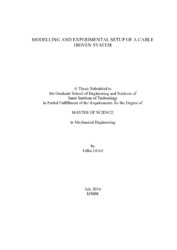Please use this identifier to cite or link to this item:
https://hdl.handle.net/11147/4858Full metadata record
| DC Field | Value | Language |
|---|---|---|
| dc.contributor.advisor | Kiper, Gökhan | - |
| dc.contributor.advisor | Dede, Mehmet İsmet Can | - |
| dc.contributor.author | Eraz, Talha | - |
| dc.date.accessioned | 2017-02-17T13:09:49Z | - |
| dc.date.available | 2017-02-17T13:09:49Z | - |
| dc.date.issued | 2016-07 | - |
| dc.identifier.citation | Eraz, T. (2016). Modelling and experimental setup of a cable driven system. Unpublished master's thesis, Izmir Institute of Technology, Izmir, Turkey | en_US |
| dc.identifier.uri | http://hdl.handle.net/11147/4858 | - |
| dc.description | Thesis (Master)--Izmir Institute of Technology, Mechanical Engineering, Izmir, 2016 | en_US |
| dc.description | Full text release delayed at author's request until 2018.08.15 | en_US |
| dc.description | Includes bibliographical references (leaves: 61-64) | en_US |
| dc.description | Text in English; Abstract: Turkish and English | en_US |
| dc.description | xi, 89 leaves | en_US |
| dc.description.abstract | This study is about a single degree of freedom mechanism to be used for human arm rehabilitation purposes and actuated with cable-drive. The purpose of the design is to support rehabilitation motions with a single degree of freedom (dof) mechanism. Design criteria is set based on research and meetings with medical doctors. The desired design is an exoskeleton type system to support human arm on each moving part of it. The first designed four- bar mechanism had actuation problems. Torque requirement was unacceptably high near the singularity of the designed four-bar mechanism. This problem is later overcome by an extra dyad of two additional links. However, the extra dyad solution caused problems of back-drivability near the singularity of new dyad. In order to achieve a back-drivable four-bar mechanism that has a smooth actuation requirement through the motion, a novel cable actuation system is designed. Cable is attached to system on coupler link and the attachment point on the coupler is designed to achieve a straight path for the efficiency of the cable drive. However, a single straight line throughout the motion is not achievable. Therefore, path is divided into subsections of straight line paths. Intermediate pulleys are placed for cable to follow straight line sections. The cable is designed as closed loop. A prototype of the system is built and presented in last chapter. | en_US |
| dc.language.iso | en | en_US |
| dc.publisher | Izmir Institute of Technology | en_US |
| dc.publisher | Izmir Institute of Technology | en_US |
| dc.rights | info:eu-repo/semantics/openAccess | en_US |
| dc.subject | Cable driven system | en_US |
| dc.subject | Medical doctors | en_US |
| dc.subject | Medical devices | en_US |
| dc.subject | Rehabilitation robotics | en_US |
| dc.title | Modelling and Experimental Setup of a Cable Driven System | en_US |
| dc.title.alternative | Kablo Tahrikli Bir Sistemin Modellenmesi ve Deney Düzeneğinin Kurulması | en_US |
| dc.type | Master Thesis | en_US |
| dc.authorid | TR226605 | - |
| dc.institutionauthor | Eraz, Talha | - |
| dc.department | Thesis (Master)--İzmir Institute of Technology, Mechanical Engineering | en_US |
| dc.request.email | kombas@gmail.com | - |
| dc.request.fullname | Talha Eraz | - |
| dc.relation.publicationcategory | Tez | en_US |
| dc.identifier.wosquality | N/A | - |
| dc.identifier.scopusquality | N/A | - |
| item.openairetype | Master Thesis | - |
| item.fulltext | With Fulltext | - |
| item.grantfulltext | open | - |
| item.openairecristype | http://purl.org/coar/resource_type/c_18cf | - |
| item.cerifentitytype | Publications | - |
| item.languageiso639-1 | en | - |
| crisitem.author.dept | 03.10. Department of Mechanical Engineering | - |
| Appears in Collections: | Master Degree / Yüksek Lisans Tezleri | |
Files in This Item:
| File | Description | Size | Format | |
|---|---|---|---|---|
| T001515.pdf | MasterThesis | 4.79 MB | Adobe PDF |  View/Open |
CORE Recommender
Page view(s)
416
checked on Jul 21, 2025
Download(s)
116
checked on Jul 21, 2025
Google ScholarTM
Check
Items in GCRIS Repository are protected by copyright, with all rights reserved, unless otherwise indicated.